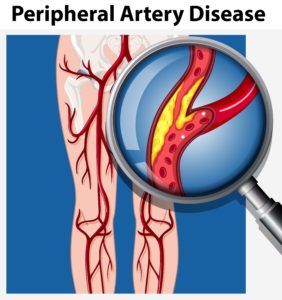Peripheral Arterial Disease, or PAD is a leading cause of limb loss in the United States. In fact, in a study from the Physical Medicine and Rehabilitation Clinics of North America, we learned that:
• Diabetics' amputation rate is 10 times higher risk than that of all others, especially for disease sufferers from African American, Hispanic, and Native Americans backgrounds.
• Vascular disease is responsible for 82% of amputations in this country.
And, while scary, these statistics are something our vascular specialists in Georgia are hoping to change.

Diabetes is a disease that impairs your body’s ability to produce or respond to insulin. If your disease is poorly controlled, your glucose levels will rise, causing arteries to narrow due to a buildup in plaque. In turn, you may experience reduced blood flow, especially in your feet and legs.
Now, cholesterol can also contribute to plaque buildup. Then, if it combines with excess glucose in your blood, the arteries narrow at a faster pace. And that increases your risk for symptoms of PAD.
Initially, you may notice that your toenails don't grow as quickly as they once did. They could become brittle and break more. Or, you could notice shrinking muscles and loss of hair on your legs. For men, erectile dysfunction could even become a concern. And all of those are signs that PAD is slowing blood flow to your lower extremities.
In addition to the symptoms we just highlighted, the reduced blood flow of PAD also increases your risk for leg ulcers and foot ulcers, deep wounds that are difficult to heal. And, if that happens, your risk for amputations in your lower limbs increases dramatically, especially if you have diabetes. But, aside from people with diabetes, who needs to worry about developing this condition? Here's what you need to know.
• People over the age of 50
• Individuals experiencing kidney failure
• People living with obese or remaining sedentary
• Smokers
• People who have high cholesterol or blood pressure levels
• Anyone with a family history of PAD
In order to treat PAD, you must receive an accurate diagnose. And, because this disease is often difficult to detect, we recommend scheduling a vascular exam in our Georgia office if you have an elevated disease risk or are experiencing any PAD symptoms.
If diagnosed with PAD, our vascular specialists will work to help you find relief using the most effective, and least invasive, treatment options. In some cases, that may mean managing your lifestyle risk factors through changes to your diet and exercise routine. However, in other instances, we may need to unblock your arteries using a minimally invasive interventional radiology procedure.
Our goal as vascular specialists is to protect your health and prevent PAD and limb loss. For support request a consultation with our specialists in Georgia. With a simple, non-invasive exam, we can help you keep your limbs!

Atlanta
3225 Cumberland Blvd. Southeast, Suite 520
Atlanta, GA 30339
Stockbridge
1035 Southcrest Dr., Suite 220 + 250
Stockbridge, GA 30281
Tucker
1975 Lakeside Pkwy., Suite 300
Tucker, GA 30084
Scheduling
Please contact our dedicated specialists to schedule a consultation today.
2025 Georgia Endovascular. All rights reserved. Website Design by Healthcare Success